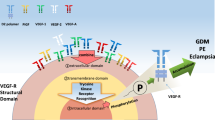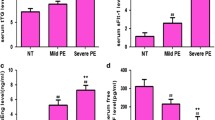Abstract
Aims/hypothesis
Elevated anti-angiogenic factors such as soluble fms-like tyrosine kinase 1 (sFlt1), a soluble form of vascular endothelial growth factor receptor, and endoglin, a co-receptor for TGFβ1, confer high risk of preeclampsia in healthy pregnant women. In this multicentre prospective study, we determined levels of these and related factors in pregnant women with type 1 diabetes, a condition associated with a fourfold increase in preeclampsia.
Methods
Maternal serum sFlt1, endoglin, placental growth factor (PlGF) and pigment epithelial derived factor were measured in 151 type 1 diabetic and 24 healthy non-diabetic women at each trimester and at term.
Results
Approximately 22 % of the diabetic women developed preeclampsia, primarily after their third trimester visit. In women with preeclampsia (diabetic preeclampsia, N = 26) vs those without hypertensive complications (diabetic normotensive, N = 95), significant changes in angiogenic factors were observed, predominantly in the early third trimester and prior to clinical manifestation of preeclampsia. Serum sFlt1 levels were increased approximately twofold in type 1 diabetic preeclampsia vs type 1 diabetic normotensive women at the third trimester visit (P < 0.05) and the normal rise of PlGF during pregnancy was blunted (P < 0.05). Among type 1 diabetic women, third trimester sFlt1 and PlGF were inversely related (r2 = 42 %; P < 0.0001). Endoglin levels were increased significantly in the diabetic group as a whole vs the non-diabetic group (P < 0.0001).
Conclusions/interpretation
Higher sFlt1 levels, a blunted PlGF rise and an elevated sFlt1/PlGF ratio are predictive of preeclampsia in pregnant women with type 1 diabetes. Elevated endoglin levels in women with type 1 diabetes may confer a predisposition to pre-eclampsia and may contribute to the high incidence of preeclampsia in this patient group.
Similar content being viewed by others
Références
Maynard SE, Min JY, Merchan J, et al. (2003) Excess placental soluble fms-like tyrosine kinase 1 (sFlt-1) may contribute to endothelial dysfunction, hypertension, and proteinuria in preeclampsia. J Clin Invest 111: 649–658
Romero R, Nien JK, Espinoza J, et al. (2008) A longitudinal study of angiogenic (placental growth factor) and anti-angiogenic (soluble endoglin and soluble vascular endothelial growth factor receptor -1) factors in normal pregnancy and patients destined to develop preeclampsia and deliver a small for gestational age neonate. J Matern Fetal Neonatal Med 21: 9–23
Levine RJ, Maynard SE, Qian C, et al. (2004) Circulating angiogenic factors and the risk of preeclampsia. N Engl J Med 350: 672–683
Author information
Authors and Affiliations
Corresponding author
Additional information
Article original: Anti-angiogenic factors and preeclampsia in type 1 diabetic women Y. Yu, A. J. Jenkins, A. J. Nankervis, K. F. Hanssen, H. Scholz, T. Henriksen, B. Lorentzen, T. Clausen, S. K. Garg, M. K. Menard, S. M. Hammad, J. C. Scardo, J. R. Stanley, A. Dashti, K. May, K. Lu, C. E. Aston, J. J. Wang, S. X. Zhang, J. X. Ma, T. J. Lyons Diabetologia (2009) 52:160–168
Rights and permissions
About this article
Cite this article
Vambergue, A. Facteurs anti-angiogéniques et prééclampsie au cours de la grossesse diabétique de type 1. Diabetol. Notes Lect. 1, 9–10 (2009). https://doi.org/10.1007/s13116-009-0005-7
Published:
Issue Date:
DOI: https://doi.org/10.1007/s13116-009-0005-7




